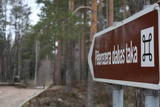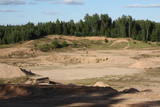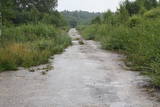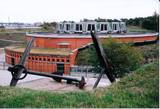| Nr | Name | Beschreibung |
|---|---|---|
|
Aiz Jodkrantes (Nidas virziens) ceļa labajā pusē ir izveidots autostāvlaukums un labiekārtota vieta, no kuras apskatāma Lietuvas (atrodamas ziņas, ka arī Eiropas) lielākā zivju gārņu Ardea cinerea un jūras kraukļu Phalacrocorax carbo kolonija, kur kopā varētu būt ~ 3000 putnu. Neaizmirstiet līdzi paņemt tālskati! |
||
|
Atrodas uz nelielās Mīlestības saliņas, ko ieskauj Buļļupes un Daugavas ūdeņi. Saliņa sasniedzama tikai ar laivu. No torņa labi pārskatāma Daugava, Daugavas vārti (ieteka jūrā), Bolderājas, Mangaļsalas un Ziemeļblāzmas apkaime, kā arī apkaimes mitrāji (niedru audzes, ūdeņi). |
||
|
Die Strandbar befindet sich am Strand und bietet eine weite Aussicht auf den Strand von Saulkrasti. Lettische Küche: Kalte Suppe, gebratenes Kabeljaufilet, hausgemachte Frikadellen, Schweinebraten, Pfannkuchen mit Quark, karamellisierte Haferflocken. |
||
|
Burtnieku muižas parks, kas atradās kungu ēkas priekšā, ir valsts nozīmes dabas aizsardzības objekts, tika izveidots ap 19.gs. 60. gadiem 10 ha platībā. Iespēja doties ekskursijā pa Burtnieku muižas parku mazākā vai lielākā grupā. Ekskursijas laikā gida pavadībā iespējams iepazīt teikām un nostāstiem bagāto parku, apskatīt teiksmaino Burtnieku ezeru, kā arī baudīt nesteidzīgu pastaigu svaigā gaisā. Papildus tiek piedāvāta iespēja iegādāties oriģinālus Burtnieku suvenīrus, kuros dažādi meistari ielikuši ne vien savu talantīgo roku darbu, bet arī Burtnieku stāstu. Lai diena būtu piepildīta, gids ieteiks, ja nepieciešams, koordinēs un dosies līdzi apskatīt arī citus dabas un vēstures objektus tuvākajā apkārtnē. |
||
|
Diese Schmalspurbahn ist eine schöne Möglichkeit, zurück in die Vergangenheit zu kehren – in die Zeit, wenn auf dem Territorium Lettland eine Epoche der Schmalspurbahnen “herrschte”. Bis zu den 60er Jahren des vorigen Jahrhunderts war die Schmalspurbahn an der Küste von Nordkurland im Einsatz und verband die an der Küste liegenden Fischerdörfer. Bis heutzutage sind die Orte (nur kaum erkennbare Korridore im Hintergrund der Natur), einzelne Stationsgebäude oder die Reste erhalten. Im Freilichtmuseum von Ventspils kann man die 1,4 km lange Ringlinie oder 3 km Berglinie interessant fahren. Am Ende der Berglinie befindet sich eine Drehscheibe. Die Lokomotive der Schmalspurbahn ist 1916 in Deutschland gebaut worden. Man kann auch ein Stationsgebäude mit ganzer Ausrüstung besichtigen. |
||
|
Geschlungener Pfad durch eine Landschaft von Dünenformationen mit Mooren, Formationen, die alte geologische Stadien der Ostsee anzeigen, das Hochmoor von Pēterezers und Überreste der alten Schmalspurbahn. Durch das Moor führen uns durch die Feuchtgebiete Holzstege. Die langgestreckten, parallel verlaufenden Dünen (kangari) und die sumpfigen Streifen dazwischen (vigas), die vom Pfad zu sehen sind, waren eng mit dem täglichen Leben der Liven verbunden, und jede von ihnen verfügt über einen eigenen livischen Ortsnamen. Der 3,5 km lange Pfad führt in die in Europa einzigartige Landschaft von kangari und vigas, die sich vor ca. 6000 Jahren gebildet hat, während das Meer zurücktrat. |
||
|
Dies sind Hügel im nördlichen Ende des Vidzemer Hochlandes. Sie sind ein wichtiges Gebiet für den Nördlichen Nadelwaldgürtel und seine Sümpfe. Hier werden verschiedene Sumpfarten gefunden, sie sind Heimat einer Anzahl wirbelloser Tiere.
|
||
|
Daugavpils – Krāslavas (A 6) ceļa malā redzamais dievnams uzcelts ar Plāteru dzimtas pārstāvju – Vaclava un Kazimira Plātera atbalstu 1811. gadā. Dievnamu ieskauj metālkaluma un no ķieģeļiem mūrēts žogs, kā arī divi zvanu torņi. Labās puses zvanu tornī karājas vecs zvans. No baznīcas iekārtas ir jāpiemin galvenais altāris, ko rotā Dievmātes skulptūra, trīs biktskrēsli, četras evaņģēlistu sienas freskas un Lurdas Dievmātes glezna. Ikdienā apskatāma no ārpuses. |
||
|
The park was established to protect the Venta River valley and the landscapes that are around its tributaries. On the west bank of the Venta, at Papilė, there is a cliff from the Jurassic period which is unique in the Baltic States, has been known since 1925, and has layers in which more than 300 forms of life have been identified over the course of time.
|
||
|
In der Windmühle des ehemaligen Landguts Tabivere wird Hausbier in verschiedenen Geschmacksrichtungen gebraut. In der Mühle können Sie Bier mit Snacks verkosten, es werden auch Workshops veranstaltet. |
||
|
Z/s Kotiņi pamatnodarbošanās ir graudkopība ar specializāciju sēklkopībā. Vieni no lielākajiem sēklas ražotājiem valstī. Apsaimniekojamās zemes platība ir 4500 ha, no kuriem 3500 ha ir augstu kategoriju sertificētas sēklas lauki. Audzē kviešus, miežus, rapsi, pupas, zirņus, auzas, rudzus, eļļas rutkus, sinepes, griķus, āboliņu, sarkano auzeni, timotiņu, Speltas kviešus. Saimniecība piedāvā produktus ar pievienoto vērtību:
Daļa no Kotiņu produktiem ir atzīti ar zaļās karotītes kvalitātes zīmi! Kotiņi ir saimniecība, kur lieto Latvijā ražotu 100% zaļu enerģiju. |
||
|
In der Bäckerei werden mehr als 50 verschiedene Arten von Backwaren angeboten. Das Konformitätszertifikat „Zaļā karotīte" („Grüner Löffel“) wurde für das Roggenbrot „Arona" vergeben. Mit "Bordo karotīte" („Bordeauxroter Löffel“) zertifizierte Produkte – Roggenbrot, süß–saures Brot, Latgale–Kastenbrot, gewelltes Weißbrot, Roggen–Klonbrot, Cesvaine–Klonbrot, Madona–süß–saures–Brot, Birži–süß–saures–Brot. Die Bäckerei hat mehrmals Medaillen auf der Messe „Riga Food" erhalten. |
||
|
Südlich von Gardene war in der Zeit der Sowjetunion einer von der größten Militärversuchsfelder der Panzer in baltischen Kriegsgebiet. Heutzutage wird der größte Teil des Militärversuchsfeldes nicht bewirtschaftet und das Territorium bewächst langsam. Im Territorium sind einzelne Gebäudefragmente oder Ruinen u.a. für die Militärversuchsfelder charakteristischen Elemente erhalten geblieben. Von dem Weg Dobele – Annenieki, der nach Militärversuchsfeld führt, zweigt sich ein betonierter Armeeweg ab, der auch heute benutzt werden kann. Die Bebauung von Gardenes ist auch sehr interessant – die Gebäude und die Planung der Gebäude. In dieser Zeit wohnten in Gardene die Soldaten der sowjetischen Armee und ihre Familien.
|
||
|
Schon seit der früheren Zeiten – ein Platz von der militärischen und strategischen Bedeutung. Für den Schutz des Hafens von Klaipeda wurde 1866 von preussischer Militär den Bau einer Festung angefangen. Im Laufe des 2.Weltkriegs wurde die Festung in die Luft gesprängt. Die Renovierung begann 1979. |
||
|
Kadarbiku estate is located in Harju, in the municipality Saue, in the village Tula (Tuula). Agriculture started to work here in 1989, while the family company Kadarbiku Köögivili OÜ was established in 2004. Kadarbik farms specializes in growing and processing vegetables. The farm uses 500 hectares of land, which grows carrots, cabbage, beets and various summer crops. They also make juices and smoothies. |
||
|
Ein kleiner Produzent, der in seinem Betrieb Erdbeeren anbaut sowie Fisch nach dem estnischen Rezept räuchert und mariniert. Außerdem werden hier Honigbier und Hauswein sowie verschiedene Fleischprodukte hergestellt. |
||
|
Das Restaurant befindet sich am Strand. Speisen werden hier aus frischen Produkten und auf lebendigem Feuer vorbereitet. Lettische Küche: Gesalzener Hering, geräucherter Aal aus dem See Razna, gebratene Gansleber, Lammfleischsuppe, Schweinerippen. Das besondere Gericht: Bujabesa: geschmorte Fische nach dem Geschmack des Restaurants. |
||
|
Noch vor kurzem befand sich das Kabinett in dem ehemaligen Haus der Einigkeit von Sauka, wo die Berufsschule von Sauka hauste. Seit 2010 ist die mit dem Kabinett verbundene Ausstellung in die Räume der Gemeindeverwaltung von Sauka nach Lone versetzt worden. Mārtiņš Buclers (1866 – 1944) war der Grundleger der lettischen Fotografie, weil er das erste Unternehmen in Lettland gegründet hat, das Filme und Fotopapier hergestellt hat. Es ist wert, die Ausstellungsgegenstände heute – in dem digitalen Fotozeitalter – zu kennenlernen! An dem Haus der Einigkeit von Sauka (zurzeit geschlossen und nur von außen zu besichtigen) kann man den Gedenkstein und das DenkmalFotografie 150 besichtigen, die Mārtiņš Buclers gewidmet sind. |
||
|
The Barefoot Path begins at the Valguma Pasaule Recreation Centre by Lake Valgums, which is surrounded by forest. The recreation centre includes a hotel and restaurant, and offers nature-based services such as the Barefoot Path and other walking trails. The Barefoot Path is a 2.6 km long trail through the natural environment, along which visitors walk barefoot and experience a variety of surfaces including pine cones, glass balls, small stones and shingles of various shapes, moss, fine sand, clay, river water, turf, gravel, reeds, chipped wood, pinewood logs, wooden poles and millstones. Walking barefoot has a number of positive health effects: it strengthens the immune system; it improves blood circulation and stabilises blood pressure; it strengthens the leg and foot muscles, joints and ligaments; and it enhances relaxation, and aids mental and physiological stability. The walk is led by an English-speaking guide. Before the walk, visitors receive a briefing. It is recommended that visitors wear comfortable outdoor clothing, appropriate for the weather. After walking the barefoot path, visitors usually feel energised, strong and happy. The walk finishes with a relaxing herbal foot bath. |
||
|
A bridge for pedestrians and bicyclists, which is on the border of the Slītere National Park. |
||





























